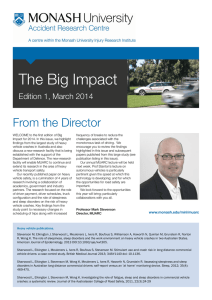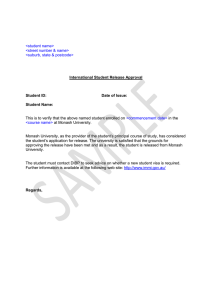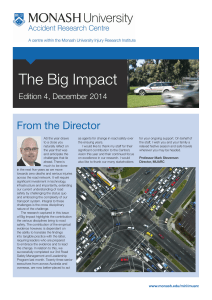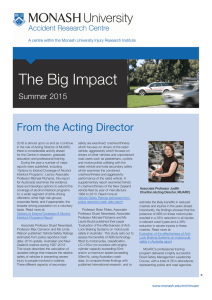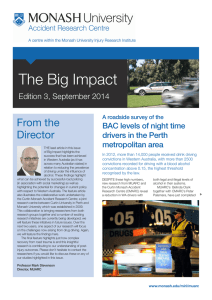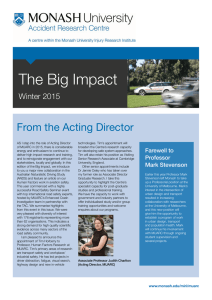The Big Impact From the Director Safety-in-Numbers:
advertisement
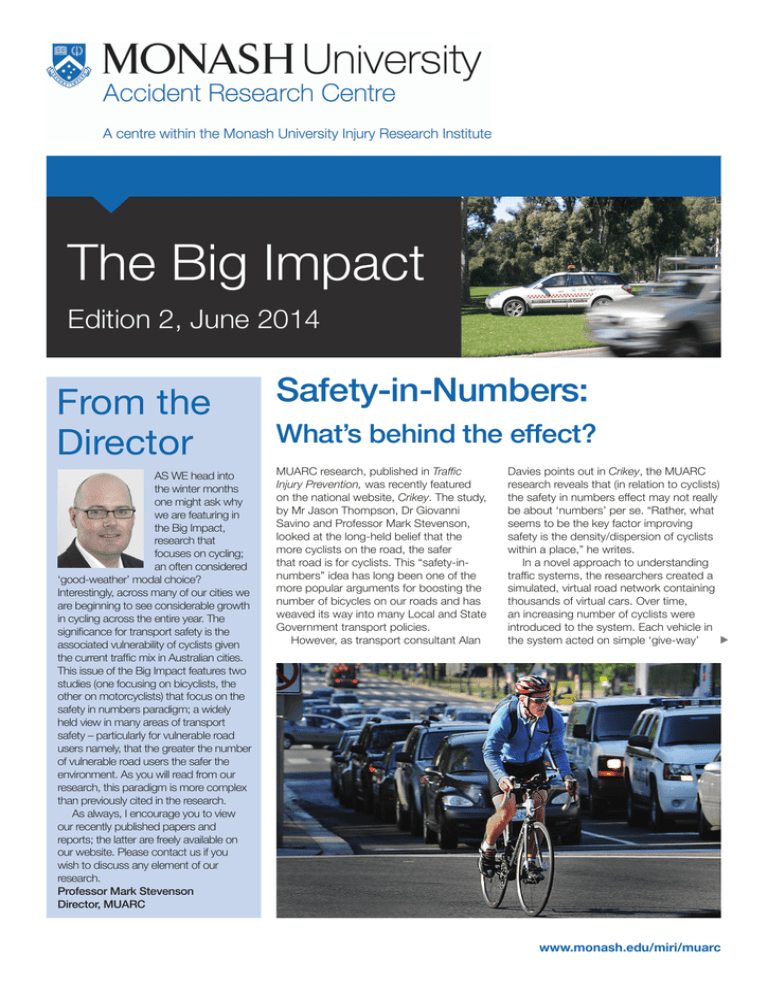
The Big Impact Edition 2, June 2014 From the Director AS WE head into the winter months one might ask why we are featuring in the Big Impact, research that focuses on cycling; an often considered ‘good-weather’ modal choice? Interestingly, across many of our cities we are beginning to see considerable growth in cycling across the entire year. The significance for transport safety is the associated vulnerability of cyclists given the current traffic mix in Australian cities. This issue of the Big Impact features two studies (one focusing on bicyclists, the other on motorcyclists) that focus on the safety in numbers paradigm; a widely held view in many areas of transport safety – particularly for vulnerable road users namely, that the greater the number of vulnerable road users the safer the environment. As you will read from our research, this paradigm is more complex than previously cited in the research. As always, I encourage you to view our recently published papers and reports; the latter are freely available on our website. Please contact us if you wish to discuss any element of our research. Professor Mark Stevenson Director, MUARC Safety-in-Numbers: What’s behind the effect? MUARC research, published in Traffic Injury Prevention, was recently featured on the national website, Crikey. The study, by Mr Jason Thompson, Dr Giovanni Savino and Professor Mark Stevenson, looked at the long-held belief that the more cyclists on the road, the safer that road is for cyclists. This “safety-innumbers” idea has long been one of the more popular arguments for boosting the number of bicycles on our roads and has weaved its way into many Local and State Government transport policies. However, as transport consultant Alan Davies points out in Crikey, the MUARC research reveals that (in relation to cyclists) the safety in numbers effect may not really be about ‘numbers’ per se. “Rather, what seems to be the key factor improving safety is the density/dispersion of cyclists within a place,” he writes. In a novel approach to understanding traffic systems, the researchers created a simulated, virtual road network containing thousands of virtual cars. Over time, an increasing number of cyclists were introduced to the system. Each vehicle in u the system acted on simple ‘give-way’ www.monash.edu/miri/muarc Safety-in-Numbers: What’s behind the effect? continued rule in order to try to avoid collisions with one another. Sometimes, they failed. According to the researchers, the safety in numbers effect could easily be replicated within the simulation, mimicking the pattern of both route selection and crash results seen in real world studies. It could also, however, be just as easily made to disappear by increasing the tendency of cyclists to disperse throughout the road network. Drawing parallels from herd behaviour seen in biology, Mr Thompson said that increasing bicycle density coinciding with increasing volume may simply reduce the proportion of surface area per cyclist exposed to danger from cars. “Fish, birds, and other flocking species naturally increase their density in the presence of threats to reduce risk of predation by minimising high-risk exposure at the periphery of groups. The effect is a simple function of surface area to volume but it is very effective. We are not saying that cyclists do this consciously at all, but increasing cyclist density may have the same effect”. The MUARC study suggests that simply increasing the number of cyclists on the roads might not improve safety if riders are dispersed widely across the road network. Conversely, stable or even decreasing numbers of cyclists concentrated on high density routes may make riding safer. In the Crikey article Mr Davies highlights the authors’ point that, “It is possible that cycling ‘activism’ and desire to reclaim territory from cars in cities where cycling has experienced a relatively recent cultural renaissance may inadvertently play a role in increasing exposure to risk”. “While there’s no doubt cycling is safer in places with more cyclists, the reasons aren’t as straightforward as is commonly assumed,” he said. What is the Safety-in-Numbers Theory? THE Safety in Numbers phenomenon refers to the idea that the more vehicles there are on the road the safer the road becomes for both drivers and cyclists. In a 2003 study, Californian engineer, Peter Jacobsen, first documented the concept in the journal Injury Prevention. He found that doubling the number of cyclists on the road tends to bring about a 1/3 drop in the per-cyclist frequency of a crash with a motor vehicle. And tripling the rate of cycling cuts the crash rate in half. Coronial Council of Victoria appointment MUARC Director, Professor Mark Stevenson has been appointed to the Coronial Council of Victoria. ESTABLISHED under the Coroners Act 2008 (Vic) to provide advice to the Attorney-General regarding matters of importance to the coronial system, the Council provides advice on: • the identification of themes, trends and patterns that may be emerging, including regional issues • legislative issues • proposed law reform activities. Membership of the council comprises the State Coroner, the Director of the Victorian Institute of Forensic Medicine (VIFM), the Chief Commissioner of Police and five to seven persons appointed by the Governor in Council on the recommendation of the Attorney- 2 www.monash.edu/miri/muarc General. The Coronial Council of Victoria is obliged to act in a way that: • does not impinge on the independence of coroners’ decisionmaking and investigation of death as well as the role of the State Coroner • delivers strategic advice reflecting the changing physical, social and political environment to foster a modern and responsive coronial system • promotes and strengthens different relationships including collaboration between agencies across the service system • focuses on advice to strengthen services to families and improve the prevention role of the coroner • ensures that the views of bereaved families are reflected in the development of advice • complements existing governance structures in the State coronial system (for example, the VIFM Council) • promotes transparency, accessibility and accountability regarding the functions of the Victorian coronial system. Professor Pauline Nestor, Senior ViceProvost and Vice-Provost (Research) at Monash University congratulated Professor Stevenson on the appointment which was made on 13 May, 2014. Study finds the more motorcycles on the roads the safer for all drivers Over equivalent distances, the Australian rate of motorcyclist deaths is approximately 30 times the rate for car occupants, with more than 200 motorcyclists killed on Australian roads annually. NEW research helps explain the frequency of motorcycle collisions with cars, finding drivers are slower to notice motorbikes when there are fewer motorbikes on the road. Dr Vanessa Beanland, formerly from Monash and now at the Australian National University’s (ANU) Research School of Psychology, together with MUARC’s Professor Mike Lenné and Professor Geoffrey Underwood, from the University of Nottingham found motorists would see and react to motorcycles up to three seconds faster when more motorbikes were on the road. Published in Attention, Perception and Psychophysics, the researchers revealed results from a study using a driver simulator to determine whether an increased prevalence of motorcyclists in traffic would improve drivers’ detection of motorcylcists in traffic. Forty drivers were involved in the study, with each participant completing two drives in the MUARC simulator. Both drives were on urban roads and the level of traffic was relatively constant comprising a mix of motorcycles and vehicles. In the first drive participants were told to obey normal road rules and to pay attention to surrounding traffic, however the prevalence of motorcycles on road varied significantly. In the following drive participants essentially did the same task but also used two custom-made buttons on the steering wheel to indicate every time they passed a bus or a motorcycle. They were also asked to verbally identify the motorcycle and bus. This is the first time that a study has used a simulator to test the safety in numbers effect. Previously studies involved the appearance of static images on a screen. The study found that the driver was more likely to notice other road users if they were more prevalent in traffic. According to Professor Mike Lenné this may explain why drivers are less likely to see motorcycles and take them into consideration on the road, because they are generally less common than cars. In the study – when motorcycles were more prevalent in the simulator scenario – they were detected on average 51 metres away, allowing an extra three seconds for the driver to respond compared to when the motorcycles are in low numbers on the screen. According to Professor Lenné, the research has practical implications as it suggests that many driver errors may occur because of the driver’s expectations about the types of vehicles they expect to encounter on the road. www.monash.edu/miri/muarc 3 Below is a sample of recent MUARC publications Thompson J, Savino G, Stevenson M. Reconsidering the safety in numbers effect for vulnerable road users: an application of agent-based modelling. Traffic Injury Prevention. 2014 DOI:10.10 80/15389588.2014.914626 Beanland V., Lenne M., Underwood G, 2014 Safety in numbers: Target prevalence affects the detection of vehicles during simulated driving. Atten Percept Psychophys, Vol 76: 805-813. DOI: 10.3758/ s13414-013-0603-1 Salmon P., Lenne M., Walker G., Stanton N., Filtness A. 2014 Exploring schema-driven differences in situation awareness between road users: an onroad study of driver, cyclist and motorcyclist situation awareness. Ergonomics. Volume 57 Issue 2, Pages: 191-209. Cassell E., Newstead S., 2014. Did compulsory wear regulations Further information Monash University Accident Research Centre (MUARC) Building 70, Clayton Campus Monash University, VIC 3800 Telephone: +61 3 9905 4371 Email: miri-enquiry@monash.edu 4 www.monash.edu/miri/muarc increase personal flotation device (PFD) use by boaters in small power recreational vessels? A before-after observational study conducted in Victoria, Australia. Injury Prevention. Doi:10.1136/ injuryprev-2014-041170 Young K., Salmon P., 2014. Sharing the responsibility for driver distraction across road transport systems: A systems approach to the management of distracted driving. Accident Analysis and Prevention. DOI: 10.1016/j. aap.2014.03.017 Rizzi M., Strandroth J., Kullgren A., Tingvall C., Fildes B. 2014. Effectiveness of Motorcycle Antilock Braking Systems (ABS) in Reducing Crashes, the First Cross-National Study. Traffic Injury Prevention. DOI: 10.1080/15389588.2014.927575 Tsay A., Savage G., Allen T., Proskel U., 2014. Limb position sense, proprioceptive drift and muscle thixotropy at the human elbow joint. 2014. Journal of Physiology. DOI: 10.1113/ jphysiol.2013.269365 Stevenson M, Johnson M, Oxley J, Meuleners L, Gabbe B, Rose G. Safer cycling in the urban road environment. Injury Prevention 2014, [10 06 2014]: DOI:10.1136/ injuryprev-2014-0141287 Newnam S, Sheppard DM, Griffin M, McClure R, Heller G, Sim M, Stevenson M. Work-related road traffic injury: a multilevel systems protocol. Injury Prevention 2014 doi:10.1136/ injuryprev-2013-041132 Stevenson M, Thompson J. On the road to prevention: road injury and health promotion. Health Promotion Journal of Australia. 2014, 25, 4-7
